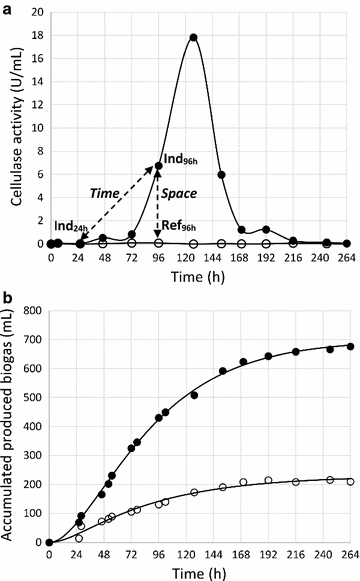Metaproteomics-guided selection of targeted enzymes for bioprospecting of mixed microbial communities
- PMID: 28523076
- PMCID: PMC5434538
- DOI: 10.1186/s13068-017-0815-z
Metaproteomics-guided selection of targeted enzymes for bioprospecting of mixed microbial communities
Abstract
Background: Hitherto, the main goal of metaproteomic analyses has been to characterize the functional role of particular microorganisms in the microbial ecology of various microbial communities. Recently, it has been suggested that metaproteomics could be used for bioprospecting microbial communities to query for the most active enzymes to improve the selection process of industrially relevant enzymes. In the present study, to reduce the complexity of metaproteomic samples for targeted bioprospecting of novel enzymes, a microbial community capable of producing cellulases was maintained on a chemically defined medium in an enzyme suppressed metabolic steady state. From this state, it was possible to specifically and distinctively induce the desired cellulolytic activity. The extracellular fraction of the protein complement of the induced sample could thereby be purified and compared to a non-induced sample of the same community by differential gel electrophoresis to discriminate between constitutively expressed proteins and proteins upregulated in response to the inducing substance.
Results: Using the applied approach, downstream analysis by mass spectrometry could be limited to only proteins recognized as upregulated in the cellulase-induced sample. Of 39 selected proteins, the majority were found to be linked to the need to degrade, take up, and metabolize cellulose. In addition, 28 (72%) of the proteins were non-cytosolic and 17 (44%) were annotated as carbohydrate-active enzymes. The results demonstrated both the applicability of the proposed approach for identifying extracellular proteins and guiding the selection of proteins toward those specifically upregulated and targeted by the enzyme inducing substance. Further, because identification of interesting proteins was based on the regulation of enzyme expression in response to a need to hydrolyze and utilize a specific substance, other unexpected enzyme activities were able to be identified.
Conclusions: The described approach created the conditions necessary to be able to select relevant extracellular enzymes that were extracted from the enzyme-induced microbial community. However, for the purpose of bioprospecting for enzymes to clone, produce, and characterize for practical applications, it was concluded that identification against public databases was not sufficient to identify the correct gene or protein sequence for cloning of the identified novel enzymes.
Keywords: Biofuel; Biogas; Bioprospecting; Cellulase; Enzyme discovery; Extracellular; Induction; Metaproteome; Microbial community; Protein inference.
Figures



Similar articles
-
Applying theories of microbial metabolism for induction of targeted enzyme activity in a methanogenic microbial community at a metabolic steady state.Appl Microbiol Biotechnol. 2016 Sep;100(18):7989-8002. doi: 10.1007/s00253-016-7547-z. Epub 2016 Apr 26. Appl Microbiol Biotechnol. 2016. PMID: 27115757
-
In silico evaluation of a targeted metaproteomics strategy for broad screening of cellulolytic enzyme capacities in anaerobic microbiome bioreactors.Biotechnol Biofuels Bioprod. 2022 Mar 18;15(1):32. doi: 10.1186/s13068-022-02125-x. Biotechnol Biofuels Bioprod. 2022. PMID: 35303956 Free PMC article.
-
Metagenomic and metaproteomic analyses of a corn stover-adapted microbial consortium EMSD5 reveal its taxonomic and enzymatic basis for degrading lignocellulose.Biotechnol Biofuels. 2016 Nov 9;9:243. doi: 10.1186/s13068-016-0658-z. eCollection 2016. Biotechnol Biofuels. 2016. PMID: 27833656 Free PMC article.
-
Bioprospecting of functional cellulases from metagenome for second generation biofuel production: a review.Crit Rev Microbiol. 2018 Mar;44(2):244-257. doi: 10.1080/1040841X.2017.1337713. Epub 2017 Jun 13. Crit Rev Microbiol. 2018. PMID: 28609211 Review.
-
Bioprospecting of microbial enzymes: current trends in industry and healthcare.Appl Microbiol Biotechnol. 2022 Mar;106(5-6):1813-1835. doi: 10.1007/s00253-022-11859-5. Epub 2022 Mar 7. Appl Microbiol Biotechnol. 2022. PMID: 35254498 Review.
Cited by
-
Activity- and Enrichment-Based Metaproteomics Insights into Active Urease from the Rumen Microbiota of Cattle.Int J Mol Sci. 2022 Jan 13;23(2):817. doi: 10.3390/ijms23020817. Int J Mol Sci. 2022. PMID: 35055002 Free PMC article.
-
Functional Response of MBR Microbial Consortia to Substrate Stress as Revealed by Metaproteomics.Microb Ecol. 2019 Nov;78(4):873-884. doi: 10.1007/s00248-019-01360-4. Epub 2019 Apr 12. Microb Ecol. 2019. PMID: 30976843
-
Comparative Proteomic Analysis of an Ethyl Tert-Butyl Ether-Degrading Bacterial Consortium.Microorganisms. 2022 Nov 25;10(12):2331. doi: 10.3390/microorganisms10122331. Microorganisms. 2022. PMID: 36557584 Free PMC article.
-
Bioprospecting of Novel Extremozymes From Prokaryotes-The Advent of Culture-Independent Methods.Front Microbiol. 2021 Feb 10;12:630013. doi: 10.3389/fmicb.2021.630013. eCollection 2021. Front Microbiol. 2021. PMID: 33643258 Free PMC article. Review.
-
Industrial Biotechnology Based on Enzymes From Extreme Environments.Front Bioeng Biotechnol. 2022 Apr 5;10:870083. doi: 10.3389/fbioe.2022.870083. eCollection 2022. Front Bioeng Biotechnol. 2022. PMID: 35480975 Free PMC article. Review.
References
LinkOut - more resources
Full Text Sources
Other Literature Sources
Molecular Biology Databases

